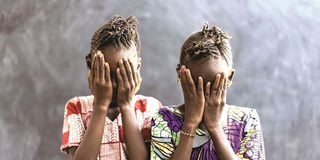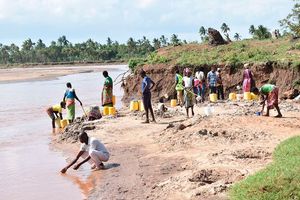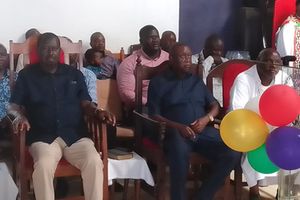Medical condition that makes you wish death upon yourself

Noma is an infection caused by multiple organisms, mostly bacteria and viruses. It starts out as a gum infection that spreads through the mouth and progresses to involve the face
What you need to know:
- Noma is an infection caused by multiple organisms, mostly bacteria and viruses. It starts out as a gum infection that spreads through the mouth and progresses to involve the face.
- The infection destroys both soft tissue and underlying bone and cartilage, leading to major disfigurement.
- The acute infection is very aggressive and progresses very rapidly. It causes severe inflammation that leaves a trail of destruction in skin, fat, muscle, connective tissues and eventually the underlying bone.
One of the reasons I chose my specialisation is because it is mostly a happy profession. Most of my patient interactions are not for ill health but for promotion of well-being. This is crowned by the joy of bringing a new person into the world. what else can beat this? I always wondered about pathologists but then again, there are people who are cut out to work with patients who mostly do not talk back.
Caring for terminally ill patients is the biggest struggle of all. To watch a patient’s condition deteriorate daily until they depart is heart-wrenching. Not only is the patient going through a devastating phase of fear, pain and helplessness; when they wish for death itself, but the family is also severely distressed by the inevitable. Nothing hurts more than knowing that your patient will probably be better off resting from the torture than having to put up with the horror of living.
What then, when they suffer an incredibly debilitating disease that could easily kill them, but surviving it is even more distressing? This is the case of Noma disease. Also known as cancrum oris, or oro-facial necrotising infection, this is a disease one wishes never to contract, and even worse, unsure whether they would like to live through it. This little-known disease, capable of wreaking such immense havoc, remains classified as a neglected tropical disease, a disease of poverty! You know there is trouble when a disease is described as predominantly found in Sub-Saharan Africa, parts of Asia and South America. It is common among children aged one to six years; who are malnourished, with poor oral hygiene; living in conditions of poor sanitation; with limited access to health care services. It has also been thought to be prevalent among people with a nomadic lifestyle, living in close residential proximity to their livestock.
Other associated risk factors include immunosuppression from HIV/Aids, use of immunosuppressive drugs such as treatment for cancer or long-standing use of steroids; co-infection with measles, malaria and tuberculosis.
Noma is an infection caused by multiple organisms, mostly bacteria and viruses. It starts out as a gum infection that spreads through the mouth and progresses to involve the face. The infection destroys both soft tissue and underlying bone and cartilage, leading to major disfigurement.
The acute infection is very aggressive and progresses very rapidly. It causes severe inflammation that leaves a trail of destruction in skin, fat, muscle, connective tissues and eventually the underlying bone. This causes immense swelling of the face, with death of the tissues, known and necrotising stomatitis and fasciitis, myonecrosis and osteonecrosis. The dead tissue literally starts to rot, with the skin turning bluish-grey before it rapidly sloughs off, leaving circular or irregular defects in the face, predominantly the cheeks, exposing the teeth and the underlying facial bones. Some teeth may become loose and eventually require extraction.
In the survivors of this ghastly disease, these defects will eventually heal with severe scarring. This will lead to remarkable functional impairment, the most dreadful disfigurement. This results in untold psychological trauma and adverse, devastating social consequences
The disease progression in Noma is very rapid, with all of this happening within a few days. Without timely and aggressive treatment, up to 90 per cent of patients will die. The death occurs from dehydration, inability to eat and the spread of infection to the rest of the body as sepsis.
The picture is not pretty for survivors. The acute period is full of pain, the patient is unable to eat, the wounds smell extremely offensive and the mouth tastes horrible. The sight of the wounds is intimidating, even to the healthcare providers. Many a patient has wondered why they survived this!
Treatment for these patients in the acute phase includes multiple antibiotic therapy; wound care with repeat cleaning and dressing; oral care by repeated rinsing with chlorhexidine antiseptic mouthwash; intravenous fluids and pain medication. Treatment for other co-existing conditions must also be done.
Thereafter, the patient will require extensive surgery by a team of specialists in order to not only restore function but also aesthetics. The scarring causes loss of mobility of facial structures, taking away abilities we take for granted such as chewing, smiling, frowning, yawning, or even sucking on a straw! The patient is in for a long ride or multiple surgeries, physiotherapy, speech therapy and tons of psychotherapy to re-establish even just a morsel of self-confidence.
It is not even possible to estimate the cost of this disease. What is clear is that prevention is the ultimate way to go. The Kenya Medical Research Institute runs a Neglected Tropical Diseases (NTD) unit. It recognises that NTDs receive relatively much less funding or attention from national governments and medical and donor communities despite the vast numbers of people affected. This is largely attributed to lack of a strong political voice to speak up for those afflicted with NTDs as they generally tend to be low profile and are poorly ranked in prioritisation in public health. This is partly because of lack of reliable statistics and ‘unpronounceable’ names of some of these diseases, hampering efforts to bring them out of the shadows.
We need to start with the basics: prevent generational malnutrition from pregnant women to their unborn baby and to the growing child. We must aim to prevent mother-to-child transmission of HIV, provide adequate nutrition monitoring for both mother and foetus, fully vaccinate our babies, and provide basic amenities for sanitation.
We must advocate for proper oral health, with oral hygiene, early diagnosis and treatment of oral health conditions as they precipitate the onset of this disease. Health education and awareness will save lives by supporting early treatment and averting severe complications. It is a race against time, just like the name Noma suggests, derived from the Greek term "voun," meaning to devour!
Dr Bosire is an obstetrician/ gynaecologist





